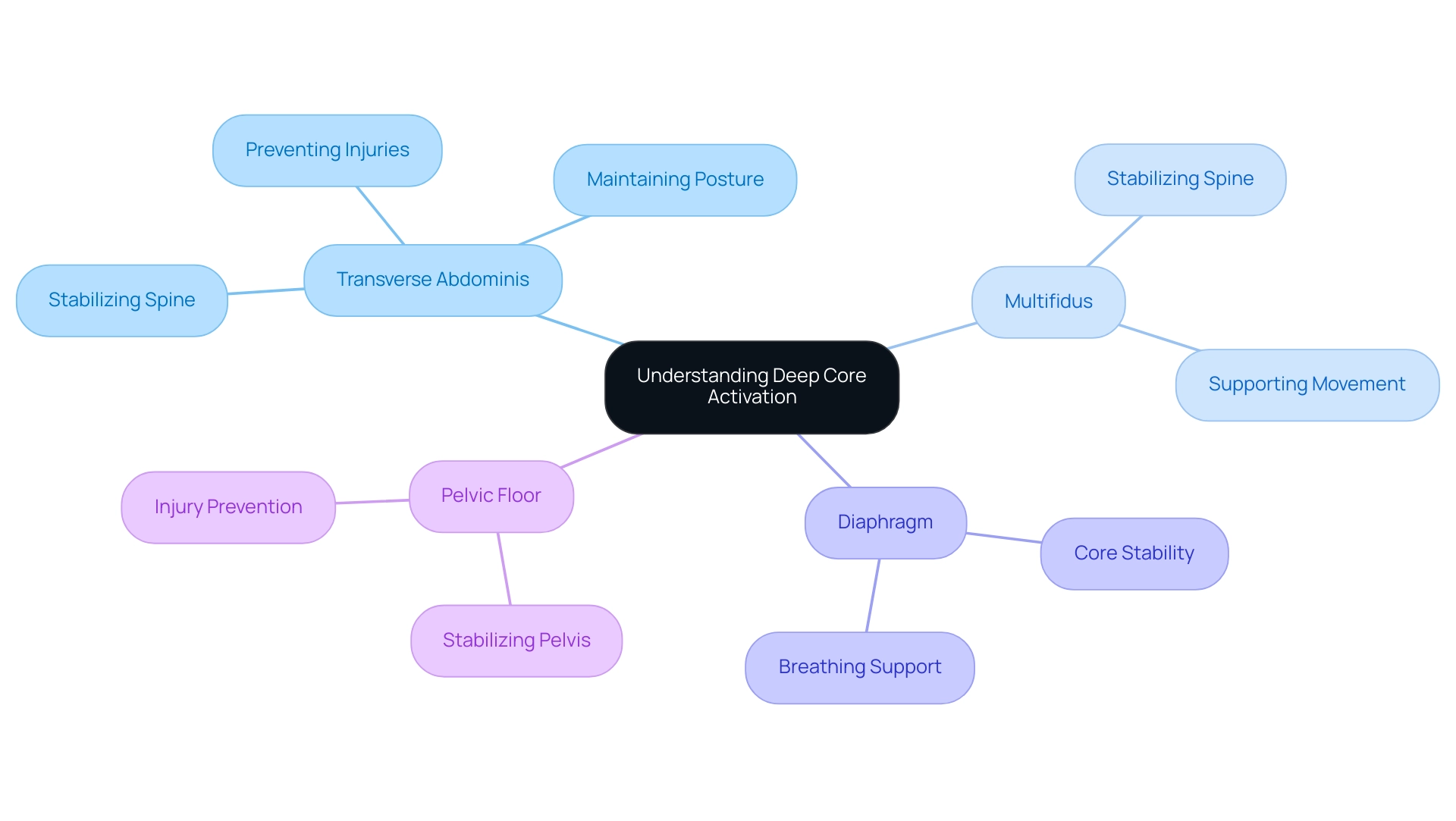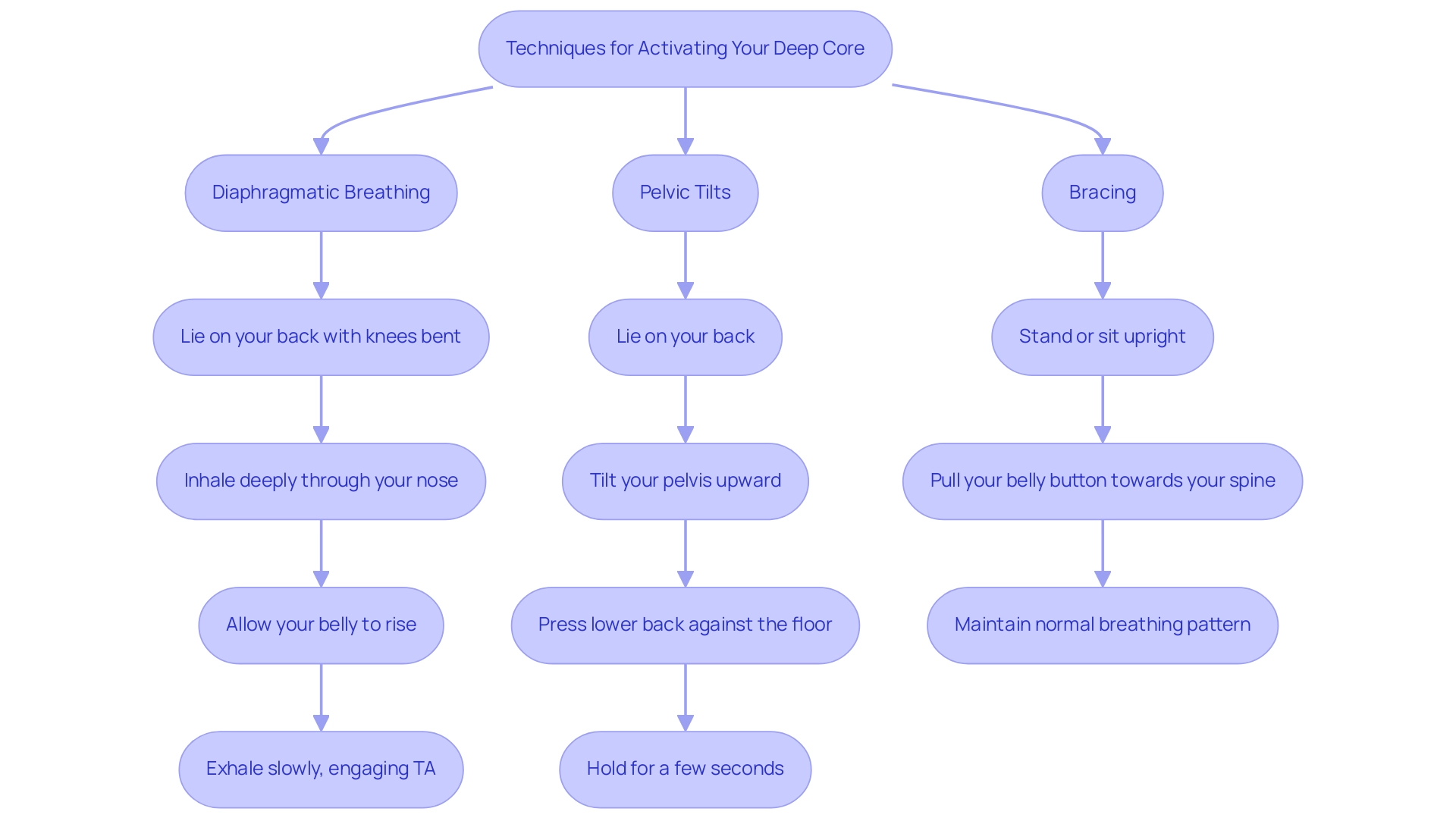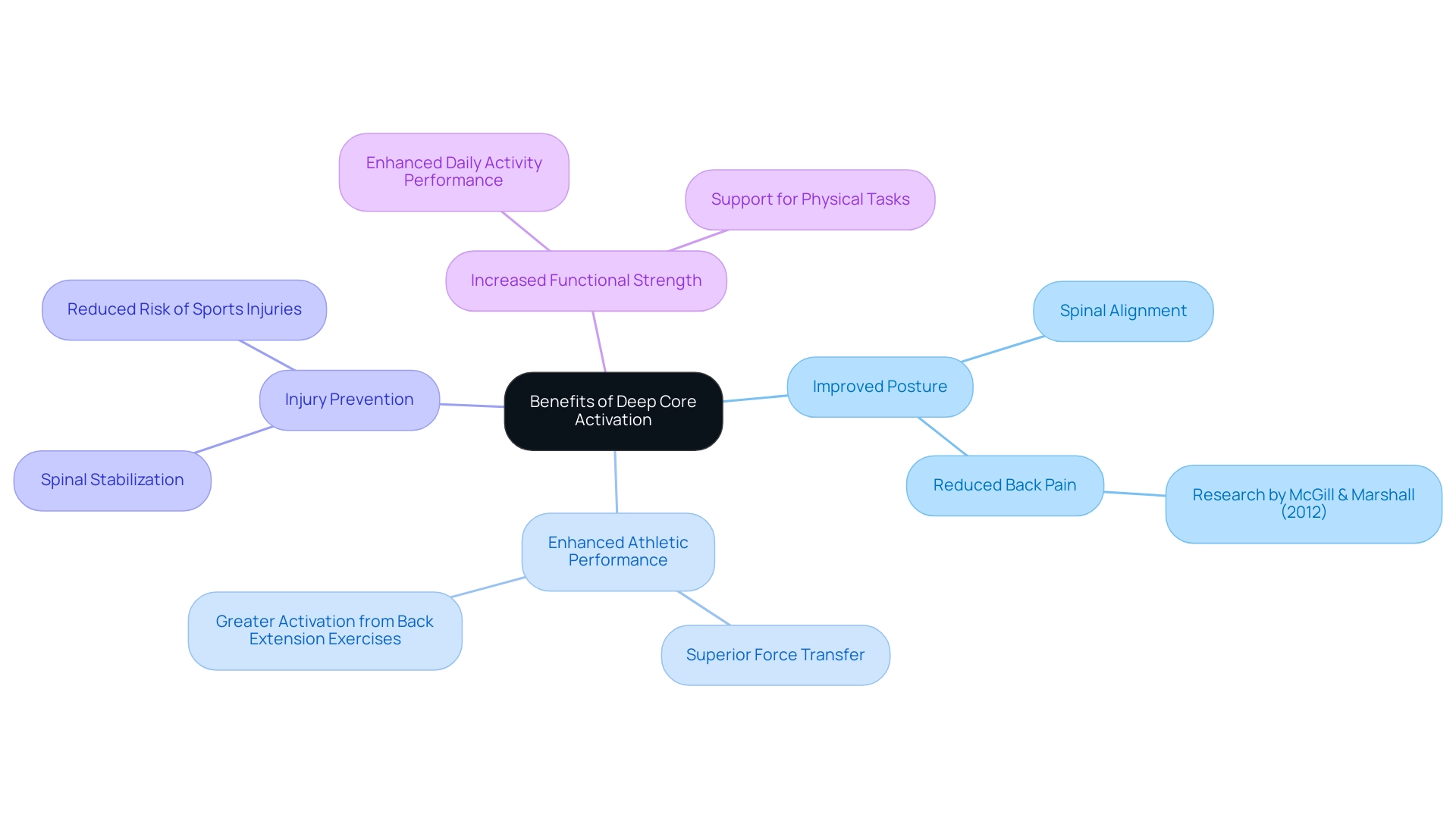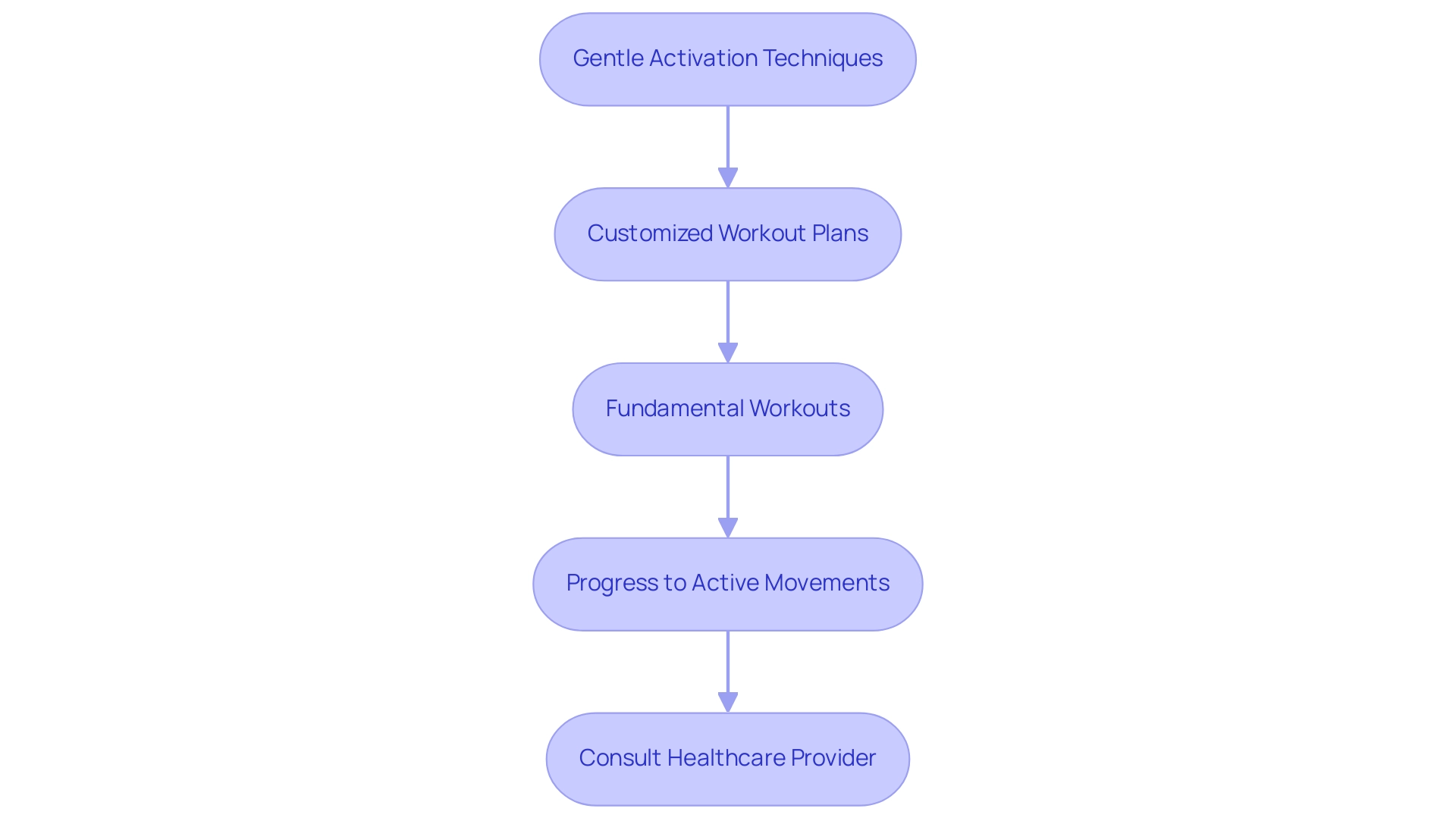Overview
Deep core activation is essential for stabilizing the spine and pelvis, involving intrinsic tissues like the transverse abdominis, multifidus, diaphragm, and pelvic floor, which collectively enhance posture, athletic performance, and injury prevention. The article underscores the importance of understanding these muscle groups and implementing specific techniques, such as diaphragmatic breathing and pelvic tilts, to effectively engage the deep core, thereby improving overall physical health and functionality.
Introduction
In the pursuit of optimal health and athletic performance, the significance of deep core activation cannot be overstated. This essential practice involves engaging a network of intrinsic muscles that stabilize the spine and pelvis, including the:
- transverse abdominis
- multifidus
- diaphragm
- pelvic floor muscles
Research has shown that effective activation of these muscles not only enhances posture but also plays a crucial role in injury prevention and athletic prowess. As individuals increasingly seek to improve their physical capabilities, understanding the anatomy, techniques, and benefits of deep core activation becomes vital. This comprehensive exploration delves into the intricacies of core muscle engagement, offering insights and practical exercises to empower anyone on their fitness journey.
Understanding Deep Core Activation
Deep core activation refers to the engagement of intrinsic tissues that are essential for stabilizing the spine and pelvis. This group includes the transverse abdominis, multifidus, diaphragm, and pelvic floor tissues. Proper deep core activation of these groups is essential not only for maintaining optimal posture but also for preventing injuries and enhancing athletic performance.
Studies show that properly implemented deep core activation methods can greatly impact the efficiency of workouts, with personal variations additionally shaping results. Notably, the level of evidence from the included studies is mainly moderate, underscoring the need for further research in this area. A case study titled 'Conclusions on Core Muscle EMG Activity' examined literature on EMG activity in central regions during various physical fitness exercises, revealing that free-weight exercises elicited the greatest activity in rectus abdominis, external obliques, and erector spinae, while traditional exercises were most effective for lumbar multifidus.
This emphasizes the significance of grasping the subtleties of fundamental engagement. Furthermore, Banafsheh Amiri notes, 'All authors contributed to and approved the final version,' emphasizing the collaborative nature of the research. This foundational knowledge is crucial for those aiming to improve their physical health and functionality in daily activities, making deep core activation an indispensable component of any fitness regimen.

Anatomy of the Deep Core Muscles
The deep center is made up of several essential tissues, each contributing greatly to spinal support and overall posture:
- Transverse Abdominis (TA): Often called the body's natural corset, the TA plays a crucial role in stabilizing the spine during movement and maintaining intra-abdominal pressure. This tissue is especially vital for overall trunk balance, as recent discoveries emphasize its significant activation in aiding the lumbar area. Research shows that the compressive spinal loading rose on the upper lumbar vertebrae by as much as 15% and fell on the lower lumbar vertebrae by up to 8%, highlighting the significance of efficient abdominal engagement.
- Multifidus: This group of small, deep tissue situated along the spine is crucial for preserving balance. They provide support during dynamic movements and help prevent excessive spinal loading, which can lead to injuries. Engaging the multifidus can greatly improve spinal support, particularly when paired with additional foundational workouts. For instance, exercises like the bird dog and side plank have demonstrated the greatest increase in thickness during hollowing, significantly engaging the transversus abdominis, internal oblique, and lumbar multifidus groups.
- Diaphragm: While mainly recognized for its function in breathing, the diaphragm also aids in central support. Its coordinated role with other essential groups allows for effective stabilization during physical activities.
- Pelvic Floor Tissues: These tissues support the pelvic organs and are essential for preserving central balance. They work in concert with the TA and multifidus to create a stable base for motion.
Comprehending these tissues and their specific roles is essential for effective deep core activation. As Dr. Drashti Sonpal observes, ‘Faulty postures resulting from a sedentary lifestyle add to a heightened risk of musculoskeletal disorders (MSDS) and cause a deterioration of the central network.’ Therefore, promoting awareness of deep core activation, especially regarding the interactions between the transverse abdominis and multifidus, is essential for improving spinal stability and avoiding injuries. Additionally, engaging in exercises such as the barbell deadlift (~90% MVIC) and hex bar deadlift (~80% MVIC) can significantly contribute to trunk activation.

Techniques for Activating Your Deep Core
To effectively activate your deep core, consider implementing the following techniques:
- Diaphragmatic Breathing: Begin by lying on your back with your knees bent. Inhale deeply through your nose, allowing your belly to rise while keeping your chest still. Exhale slowly, consciously engaging your transversus abdominis (TA). This method not only boosts central engagement but is also backed by studies showing its role in enhancing tissue thickness, especially in the transversus abdominis, internal oblique, and lumbar multifidus tissues.
- Pelvic Tilts: While lying on your back, gently tilt your pelvis upward, pressing your lower back against the floor. Hold this position for a few seconds before releasing. This simple yet effective movement can significantly enhance deep core activation when practiced consistently.
- Bracing: Stand or sit upright and imagine pulling your belly button towards your spine while maintaining a normal breathing pattern. This approach promotes fundamental balance and is crucial for developing awareness and control over deep abdominal muscles.
Incorporating real-time feedback during these activities can further enhance their effectiveness, allowing for improved self-awareness and control. According to Mansour Abdullah Alshehri, author of various studies on core stability, the regimen for deep core activation is effective in treating diastasis recti and enhancing postpartum women's quality of life. Notably, a study found that the side plank exercise resulted in a significant increase in tissue thickness compared to other exercises, with a significance level of p < 0.001.
Additionally, findings from the case study titled "Comparison of Core Stability Exercises" revealed that hollowing maneuvers led to greater thickness in the tissues than bracing, particularly in the transversus abdominis, internal oblique, and lumbar multifidus areas. By incorporating these techniques into your routine, you can cultivate a solid base for strength that supports deep core activation and overall stability.

Benefits of Deep Core Activation for Health and Performance
Activating your deep abdominal muscles provides a range of significant benefits that impact both athletic performance and overall well-being:
- Improved Posture: Strengthening the deep abdominal region enhances spinal alignment, which can lead to a notable reduction in back pain. Research indicates that individuals aged 25.60 ± 3.40 years who participate in focused abdominal workouts experience improved posture and reduced discomfort in daily activities (McGill & Marshall, 2012).
- Enhanced Athletic Performance: A strong midsection facilitates superior force transfer during physical activities, allowing athletes to perform more effectively. This foundation is essential for enhancing movements in sports, as demonstrated by research indicating that back extension exercises result in greater activation of central strength than many other workouts. Citation numbers available from Dimensions support these findings.
- Injury Prevention: By stabilizing the spine, deep core activation significantly decreases the risk of injuries sustained during sports and daily activities. The stability offered by a strong center is essential in preventing common injuries associated with physical exertion.
- Increased Functional Strength: A well-activated center supports various movements in daily life, enhancing overall functionality. This enhancement results in improved performance in everyday activities and physical tasks.
Wendi Weimar, PhD and director of the Sport Biomechanics Laboratory at Auburn University, highlights a frequent problem:
'So individuals will perform movements that they believe are targeting the ‘core’ but are not.' This emphasizes the significance of comprehending which exercises effectively target deep abdominal muscles. Recent studies emphasize the necessity of proper deep core activation, demonstrating its vital role in athletic performance and injury prevention.
Additionally, a systematic review assessed the methodological quality of studies on this topic, categorizing the level of evidence for each study as weak, moderate, or strong, which helps reduce bias when interpreting the results.

Deep Core Activation During Pregnancy and Postpartum
During pregnancy, it is crucial to implement gentle activation techniques that support deep core activation in alignment with the body's changing dynamics. Participating in diaphragmatic breathing and pelvic tilts acts as a basis for enhancing stability without inducing strain. These techniques not only enhance awareness of the essence but also prepare the body for the physical demands of labor.
As Brian Rittenhouse suggests, incorporating customized workout plans is vital for understanding the real-world implications of postpartum recovery. Following childbirth, it is essential to tackle fundamental workouts with care. Initiating a program with pelvic floor engagements allows for a safe reintroduction of activities focused on deep core activation.
As strength gradually returns, one can progress to more active movements, ensuring that each step is aligned with personal recovery goals. Consulting with a healthcare provider before starting any new fitness regimen during and after pregnancy is essential, as it guarantees a tailored approach that prioritizes safety and effectiveness. Recent studies highlight that early intervention with suitable activities can significantly aid postpartum recovery, especially for individuals facing diastasis recti, with an odds ratio for EPDS 13+ in the intervention group being 0.57 [0.43-0.76].
Moreover, a case study named "When to Start Fundamental Activities for Diastasis Recti" emphasizes the significance of consulting a healthcare professional to establish the appropriate timing for beginning abdominal activities after childbirth, demonstrating how early intervention can aid recovery and enhance results.

Effective Exercises for Deep Core Strengthening
To effectively enhance your deep abdominal muscles, consider incorporating the following activities into your training regimen:
- Plank Variations: Activate your center while maintaining a neutral spine. It's important to note that a properly executed hardstyle plank should not be held for longer than 20 seconds to maximize effectiveness. Furthermore, studies indicate that during PlankDF, over 60% of maximal voluntary isometric contraction is noted, highlighting the activity's effectiveness for engaging the central region.
- Bird-Dog: Start from a tabletop position, extending one arm and the opposite leg. This activity not only improves coordination but also involves your central muscles, making it a highly advantageous addition to your routine.
- Dead Bug: Lying on your back with arms and legs raised, lower one arm and the opposite leg while maintaining abdominal tension. This exercise encourages stability and is especially effective for improving central control.
- Bridge: While resting on your back, elevate your hips, tightening your glutes and activating your abdominal muscles. This movement targets multiple muscle groups and aids in developing central strength.
These plank variations function as both a rehabilitation approach and a fitness program for enhancing central strength through deep core activation, making them adaptable options for any training regimen. Aim for 2-3 sets of 10-15 repetitions for each movement, focusing on proper form and control. Studies suggest that activities such as the bird-dog are especially beneficial, demonstrating notable advantages in trunk activation.
Moreover, a study comparing activation techniques during fundamental workouts revealed that the hollowing maneuver, which emphasizes pulling the belly button towards the spine, is more effective than bracing for enhancing muscle thickness. This insight can guide activity selection for rehabilitation and training, especially for individuals with chronic low back pain. As noted by Jung-Hoon Choi, understanding the nuances of these techniques can lead to better outcomes.
Incorporating these exercises not only aids in rehabilitation but also enhances overall core stability through deep core activation, making them essential for effective core strengthening programs.

Conclusion
Deep core activation is a critical component for anyone looking to enhance their health and athletic performance. Engaging the intrinsic muscles such as the transverse abdominis, multifidus, diaphragm, and pelvic floor not only stabilizes the spine and pelvis but also plays a pivotal role in improving posture, preventing injuries, and boosting athletic prowess. The insights gathered from research underscore the importance of understanding these muscle groups and the techniques required for effective activation, highlighting that proper engagement can significantly affect exercise effectiveness.
Implementing techniques such as diaphragmatic breathing, pelvic tilts, and bracing can foster a strong foundation for core strength. The benefits of deep core activation extend beyond athletic performance; they encompass improved posture, increased functional strength, and a reduced risk of injury. Especially during pregnancy and postpartum, tailored activation strategies are essential for safe recovery and enhancing core stability.
Ultimately, integrating deep core activation into daily routines and fitness regimens can empower individuals to achieve their physical goals. By committing to understanding and activating these crucial muscles, individuals can pave the way for enhanced performance, greater resilience against injuries, and improved overall health. The journey towards optimal core strength is not only about physical training but also about fostering a deeper connection with one’s body and its capabilities.
Frequently Asked Questions
What is deep core activation?
Deep core activation refers to the engagement of intrinsic tissues essential for stabilizing the spine and pelvis, including the transverse abdominis, multifidus, diaphragm, and pelvic floor tissues.
Why is deep core activation important?
Proper deep core activation is crucial for maintaining optimal posture, preventing injuries, and enhancing athletic performance.
What impact does deep core activation have on workouts?
Studies indicate that correctly implemented deep core activation methods can significantly improve workout efficiency, although results may vary based on individual differences.
What did the case study 'Conclusions on Core Muscle EMG Activity' reveal?
The case study found that free-weight exercises produced the highest activity in the rectus abdominis, external obliques, and erector spinae, while traditional exercises were more effective for the lumbar multifidus.
What are the key muscles involved in deep core activation?
The key muscles involved are: Transverse Abdominis (TA), Multifidus, Diaphragm, and Pelvic Floor Tissues.
How does the transverse abdominis contribute to spinal support?
The transverse abdominis plays a crucial role in stabilizing the spine during movement and maintaining intra-abdominal pressure, which is vital for trunk balance.
What exercises can enhance deep core activation?
Exercises like the bird dog, side plank, barbell deadlift, and hex bar deadlift are effective for engaging the deep core muscles and improving spinal stability.
What are the consequences of faulty postures due to a sedentary lifestyle?
Faulty postures can increase the risk of musculoskeletal disorders and lead to a deterioration of the central network, emphasizing the need for awareness of deep core activation.

